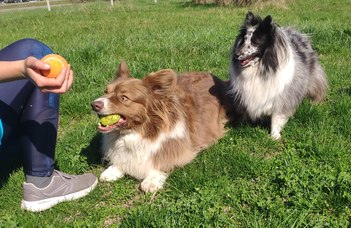Social dynamics of family dogs – A peek behind hierarchies

'Dominance' is a commonly used term, especially regarding dogs, but this has a different meaning in ethology and human psychology. The usefulness of the term, alongside 'rank' and 'hierarchy' has sparked debates in the past decade not only among dog owners and trainers, but also behavioural researchers. While the term 'dominance' in the case of humans is mostly regarded as a personality trait, in ethology it is only understandable as a qualitative measure of social relationships. But even if agreeing on the narrow definition of the term “preferential access to limited resources”, it is easy to see the problem: companion dogs do not have to compete for resources as other social animals in the wild do, so why would even they bother to establish dominance hierarchies?
Still, previous research on groups of dogs have found consistent behaviours that align with dominance/subordinance, and the group structure of these dogs resembled an established hierarchy. Other studies also found that individuals’ ranks in this hierarchy have associations with their personalities and can affect social interactions apart from direct resource competition, such as learning from each other or from a human. All in all, it seems that investigating hierarchies within groups of family dogs has real-life applications. However, measuring dominance relationships among family dogs sounds easier than in reality it would be accomplishable.
Researchers traditionally rely on citizen science methods – mainly questionnaires – because the empirical observation of dogs at their homes would not be feasible due to the sporadic occurrence of rank-related behaviours. The surveys are usually based on a handful of questions and they may serve well to get an insight about which is the higher or lower ranking dog – but how reliable they are compared to reality?
In this new project,
researchers first developed the Dog Rank Assessment Questionnaire (DRA-Q),
which consists of 8 questions about the cohabiting companion dogs’ everyday interactions that correspond to three different aspects of rank – formal rank based on submissive communicative signals, agonistic rank based on interactions around resources and leadership/group defence. When the dog owners complete the questionnaire, a 'Rank score' is assigned to the dogs involved in the study. However, the old issue still remained unsolved: is this score mirroring the 'real thing' between the dogs? To settle the question for good, they devised two experiments to validate their scoring system. They then examined how dogs’ behaviours in the 'Toy Possession Test' and 'Greeting Test' might associate with the 'Rank score' derived from the DRA-Q. Their main goal was to see, whether the behaviour of the two dogs in both tests would consistently associate with their different positions in the home-hierarchy, predicted by the DRA-Q score.
Results from both tests showed that DRA-Q assesses rank in a meaningful way.
Dogs with higher scores on two of the three aspects of rank and higher overall scores obtained the toy more often, regardless of its type, and kept it till the end of the trial. None of the dogs showed any aggression during the Toy Possession Test. In the greeting scenario, dogs with higher overall scores showed less submissive behaviours, such as licking the other dog’s muzzle, and higher scores on two aspects predicted more dominant behaviours, such as standing over the other dog. “These results show that DRA-Q can be a useful tool for assessing rank relationships between cohabiting family dogs not only in the qualitative, dominant-subordinate way, but it also makes the hierarchy position quantifiable, making it useful for investigating social dynamics in bigger groups, measuring the firmness of the hierarchy” - says Kata Vékony, PhD student and first author of the study.
It is known from previous research that different types or aspects of rank, while they were not independent of each other, did not completely overlap. “Our results now showed that it is the case in companion dogs as well. Different types of rank might be more relevant in different contexts, so while we do think the concept of dominance hierarchies in companion dog groups has its place in investigating and interpreting behaviour, using 'dominance' or 'rank' as a be-all-end-all explanation in any context could be more than misleading.” - concludes principal investigator Péter Pongrácz.
In the 'Toy Possession Test', both dogs were released at the same time when the experimenter casually threw a ball or a food-filled toy a few meters of distance in six trials. Importantly, the experimenter tried to avoid creating a fetching game or retrieval task scenario, as dogs’ motivations are different in these contexts. The researchers recorded which one of the two dogs is going to grab the target first, and which one holds it at the end of the trial.
In the 'Greeting Test', the owners had to provide a home-made video recording about a scenario, when they return from a short walk with one of their dogs, and the other dog (who stayed at home in the meantime) meets with them. Researchers then analysed the postures and interactions of the two, reuniting dogs.

